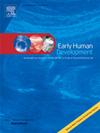高海拔暴露与唐氏综合征新生儿先天性异常的出生患病率
IF 2
3区 医学
Q2 OBSTETRICS & GYNECOLOGY
引用次数: 0
摘要
背景唐氏综合征患者由于其易感基因型可能与环境因素相互作用,先天性畸形的风险与生俱来。特别是高海拔暴露与先天性心脏病风险增加有关。然而,很少有研究探讨这一人群先天性畸形的环境风险因素,而高海拔的具体影响仍未得到充分调查。本研究旨在评估包括高海拔居住地在内的母体和环境风险因素对唐氏综合征新生儿先天性异常患病率的影响。我们从医疗记录中提取了临床病史和常住地数据,以确定潜在的风险因素。主要结果是出现重大先天性畸形。结果 共纳入了 301 例唐氏综合征病例,其中 182 例(60.5%)伴有重大先天性畸形,先天性心脏病和胃肠道畸形最为常见。产妇年龄、高海拔暴露、先兆子痫和近亲结婚与先天性畸形风险增加有显著相关性(所有 p 均为 0.05)。此外,分层分析显示,高海拔是特定畸形的重要风险因素:动脉导管未闭(OR:5.82,95 % CI:[1.68-36.65],p = 0.02)和肛门直肠畸形(OR:5.29,95 % CI:[1.结论我们的研究结果表明,母体和环境因素,尤其是高海拔暴露,在唐氏综合征新生儿先天性畸形的发展中起着至关重要的作用。这些结果表明,有必要加强对高危人群的监测和有针对性的临床管理,并进一步研究降低这些风险的预防策略。本文章由计算机程序翻译,如有差异,请以英文原文为准。
High altitude exposure and the birth prevalence of congenital anomalies in newborns with Down syndrome
Background
Individuals with Down syndrome are inherently predisposed to congenital anomalies due to a susceptible genotype that may interact with environmental factors. High-altitude exposure, in particular, has been linked to an increased risk of congenital heart disease. However, few studies have explored environmental risk factors for congenital anomalies in this population, and the specific impact of high altitude remains under-investigated. This study aimed to evaluate maternal and environmental risk factors, including high-altitude residence, on the prevalence of congenital anomalies in newborns with Down syndrome.
Methods
We conducted a cross-sectional study at two specialized genetic centers in Bolivia, including patients referred from various regions of the country. Data on clinical history and habitual residence were extracted from medical records to identify potential risk factors. The primary outcome was the presence of major congenital anomalies. Univariate and multivariate logistic regression analyses were performed to assess the association between risk factors and congenital anomalies.
Results
A total of 301 Down syndrome cases were included, of which 182 (60.5 %) presented with major congenital anomalies, with congenital heart disease and gastrointestinal anomalies being the most prevalent. Maternal age, high-altitude exposure, preeclampsia, and consanguinity were significantly associated with an increased risk of congenital anomalies (all p < 0.05). Furthermore, stratified analysis revealed that high altitude was a significant risk factor for specific anomalies: patent ductus arteriosus (OR: 5.82, 95 % CI: [1.68–36.65], p = 0.02) and anorectal anomalies (OR: 5.29, 95 % CI: [1.52–33.45], p = 0.03).
Conclusion
Our findings indicate that both maternal and environmental factors, particularly high-altitude exposure, play a crucial role in the development of congenital anomalies in newborns with Down syndrome. These results underscore the need for enhanced surveillance and tailored clinical management in high-risk populations, as well as further research into preventive strategies to mitigate these risks.
求助全文
通过发布文献求助,成功后即可免费获取论文全文。
去求助
来源期刊

Early human development
医学-妇产科学
CiteScore
4.40
自引率
4.00%
发文量
100
审稿时长
46 days
期刊介绍:
Established as an authoritative, highly cited voice on early human development, Early Human Development provides a unique opportunity for researchers and clinicians to bridge the communication gap between disciplines. Creating a forum for the productive exchange of ideas concerning early human growth and development, the journal publishes original research and clinical papers with particular emphasis on the continuum between fetal life and the perinatal period; aspects of postnatal growth influenced by early events; and the safeguarding of the quality of human survival.
The first comprehensive and interdisciplinary journal in this area of growing importance, Early Human Development offers pertinent contributions to the following subject areas:
Fetology; perinatology; pediatrics; growth and development; obstetrics; reproduction and fertility; epidemiology; behavioural sciences; nutrition and metabolism; teratology; neurology; brain biology; developmental psychology and screening.
 求助内容:
求助内容: 应助结果提醒方式:
应助结果提醒方式:


